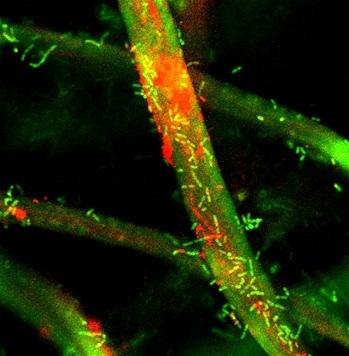
A multi-institution team, managed by DTRA CB’s Dr. Brian Pate and including David Whitten and other inventors from the University of New Mexico, University of Florida, Duke University, and the U.S. Army Natick Soldier Research, Development & Engineering Center (NSRDEC), was issued a patent on materials incorporating antimicrobial polymers.
In the patent application, the researchers describe the manufacture and use of soft surfaces such as fabrics bearing surface-grafted antimicrobial polymers. Previous work showed how certain conjugated poly-electrolytes such as Poly (phenylene ethynylene) (PPE)-based cationic conjugated polyelectrolytes (CPEs) and cationic phenylene ethynylene oligomers (OPEs) exhibit dark and light-activated biocidal activity against Gram positive and Gram negative bacteria and bacterial spores.
In addition, coatings on solid surfaces (both physisorbed, chemisorbed, or covalently grown) can also entrap and kill bacteria either in the dark or upon irradiation with light absorbed by the conjugated poly-electrolyte.
Using this knowledge, the team believes they can apply it to coatings and materials used for bedding, a variety of hospital garments and instruments, and air filtration systems. In addition, the researchers see applications for medical implants, clothing and even paints for surfaces.
The application cites the need for new methods for providing antimicrobial protection to textiles and novel textiles having antimicrobial properties, including those for soldier protection.
Source: Courtesy of John Davis, Defense Threat Reduction Agency’s Chemical and Biological Technologies Department, via Armed with Science.


